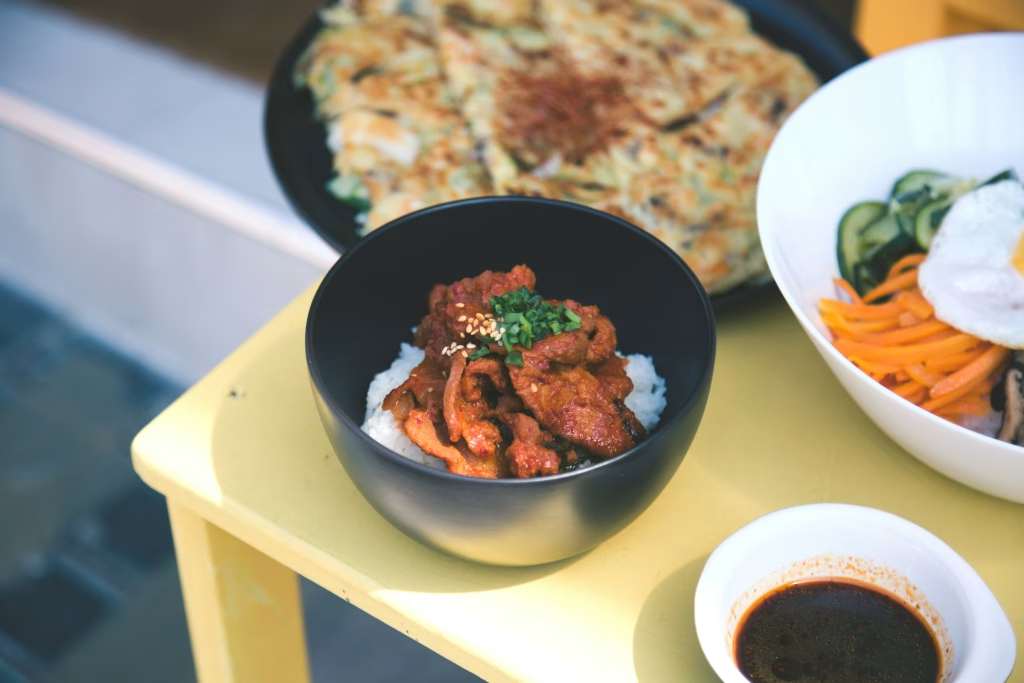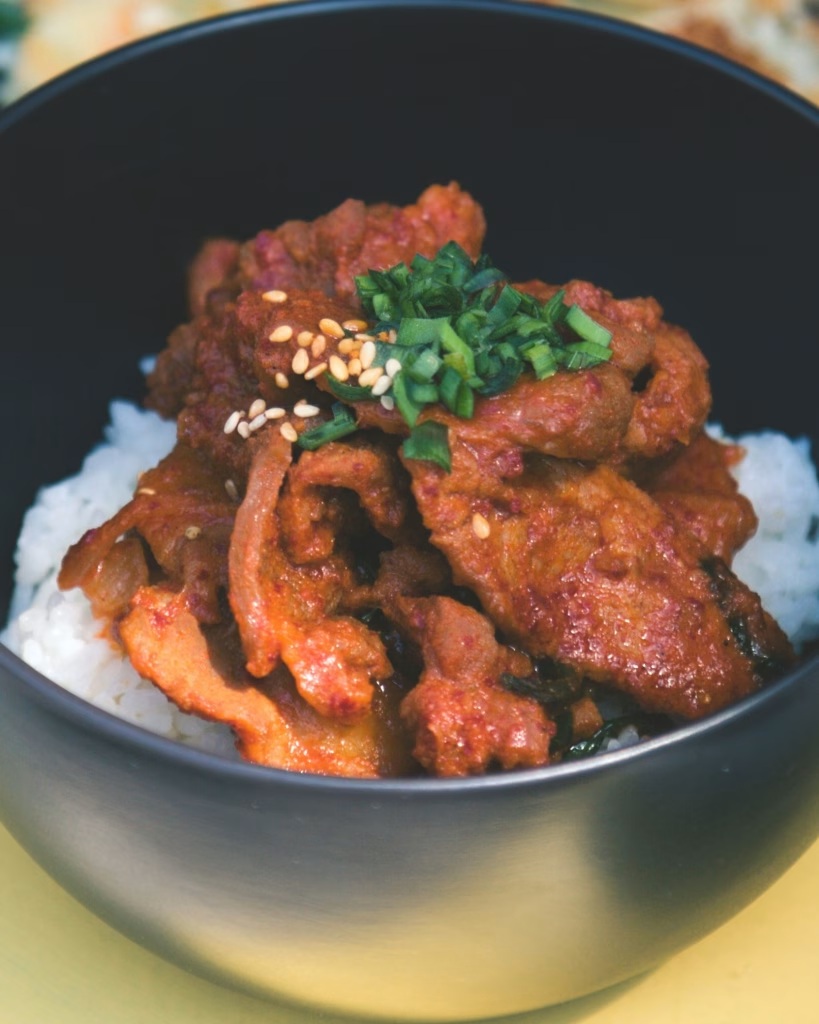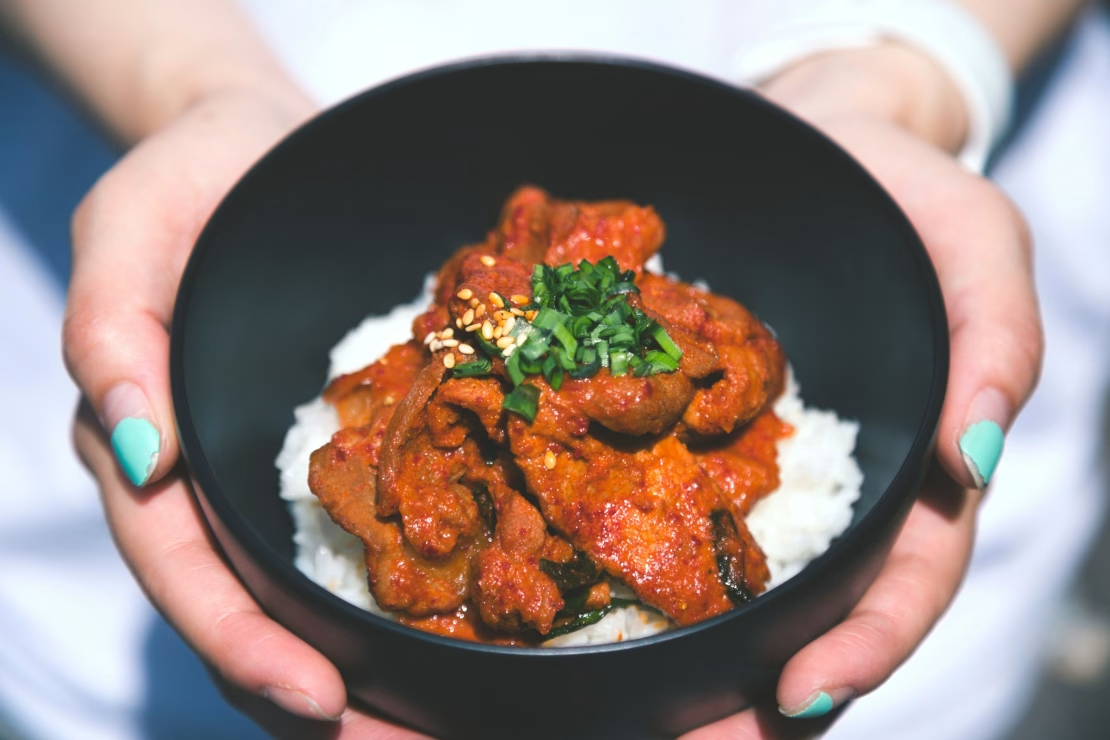Spicy Korean Pork Bulgogi known in Korean as Dwaeji Bulgogi (돼지불고기) is a sizzling, flavor-packed dish made with thinly sliced pork marinated in a rich blend of gochujang (Korean chili paste), garlic, ginger, soy sauce, sesame oil, and more.
This iconic dish balances the signature Korean elements of sweet, spicy, savory, and umami. Bulgogi means “fire meat,” and while traditionally grilled over open flames, this spicy pork version can also be pan-fried or stir-fried, making it easy to prepare at home. Bursting with bold flavors and often served with rice, lettuce wraps, or side dishes (banchan), Spicy Korean Pork Bulgogi is a must-try for lovers of Korean cuisine.
Table of Contents
Ingredients
For the Marinade:
- 500g (1.1 lbs) pork shoulder or pork belly (thinly sliced)
- 2 tablespoons gochujang (Korean red chili paste)
- 1 tablespoon gochugaru (Korean red chili flakes) – optional, for extra heat
- 3 tablespoons soy sauce
- 2 tablespoons mirin (or rice wine)
- 1 tablespoon sesame oil
- 1 tablespoon sugar (white or brown)
- 1 tablespoon honey (or corn syrup)
- 1 tablespoon rice vinegar (optional, for slight tang)
- 4 cloves garlic (minced)
- 1-inch piece fresh ginger (grated)
- 2 tablespoons grated Korean pear or apple (acts as natural tenderizer)
- 2 green onions (chopped)
- Pinch of black pepper
For Cooking & Serving:
- 1 tablespoon vegetable oil
- 1 onion (sliced)
- 1 small carrot (julienned)
- 1 bell pepper (optional, sliced)
- Toasted sesame seeds (for garnish)
- Additional chopped green onions
- Steamed white rice
- Lettuce leaves (for wraps)
- Kimchi and other banchan (optional)
Serves
Serves: 3–4 people
Preparation Time: 15 minutes
Marination Time: 30 minutes to 2 hours (or overnight)
Cooking Time: 10–12 minutes
Total Time: ~45 minutes (excluding marination)
Step-by-Step Instructions
Step 1: Slice the Pork Thinly
Use partially frozen pork shoulder or belly to make thin slicing easier. Aim for slices no thicker than 1/8 inch. Place in a large mixing bowl.
Step 2: Prepare the Marinade
In a separate bowl, whisk together gochujang, gochugaru, soy sauce, mirin, sesame oil, sugar, honey, rice vinegar, garlic, ginger, grated pear, and black pepper. Mix well until smooth.
Step 3: Marinate the Pork
Pour the marinade over the sliced pork and mix thoroughly, massaging the marinade into the meat. Add chopped green onions. Cover and refrigerate for at least 30 minutes, or up to 24 hours for maximum flavor.
Step 4: Cook the Pork
Heat a large skillet or grill pan over medium-high heat. Add a tablespoon of oil. Once hot, sauté the sliced onions and carrots for 2 minutes, then add the marinated pork.
Spread the meat out evenly in the pan. Avoid overcrowding—cook in batches if necessary. Let the pork sear for 2–3 minutes before stirring to allow caramelization.
Continue to stir-fry until pork is fully cooked, slightly charred, and the sauce is thickened and glossy—about 8–10 minutes.
Step 5: Garnish and Serve
Sprinkle with toasted sesame seeds and extra green onions. Serve immediately with steamed rice, lettuce leaves for wrapping, and optional banchan.

Serving Suggestions
- Traditional Style: Serve hot over steamed short-grain white rice.
- Korean BBQ Style: Wrap in lettuce leaves with rice, kimchi, garlic slices, and ssamjang (Korean dipping sauce).
- Bibimbap Bowl: Use as a protein topping in a rice bowl with sautéed veggies, fried egg, and gochujang.
- On Noodles: Try it over glass noodles or ramen for a fusion twist.
- Meal Prep Idea: Store leftovers for rice bowls or wraps throughout the week.
Tips for Perfect Spicy Pork Bulgogi
- Use Pork Shoulder or Belly: These cuts have the ideal fat content to keep the meat juicy and flavorful.
- Thin Slicing is Key: Thin slices absorb marinade faster and cook quickly and evenly.
- Grate Fruit for Tenderizing: Korean pear or apple helps tenderize the meat naturally.
- Don’t Skip Gochujang: It gives the dish its signature Korean depth and spiciness.
- Char Slightly for Authenticity: Slight caramelization adds authentic “BBQ” flavor even on a stovetop.
Healthier Alternatives
- Use Lean Pork Loin: Reduces fat while keeping good flavor (though less juicy).
- Cut Sugar by Half: Reduce added sugar and rely more on fruit sweetness.
- Lettuce Wraps Instead of Rice: Lower-carb option with added crunch and freshness.
- Air-Fry the Pork: For a lower-oil version, cook the marinated pork in an air fryer at 200°C (392°F) for 8–10 minutes.
- Add More Vegetables: Toss in cabbage, zucchini, or spinach to bulk up nutrition.
Creative Variations
- Spicy Chicken Bulgogi: Replace pork with thinly sliced chicken thighs.
- Tofu Bulgogi: Use firm tofu slices for a vegetarian version—press to remove moisture before marinating.
- Korean Bulgogi Tacos: Serve in tortillas with cabbage slaw and gochujang mayo.
- Bulgogi Sliders: Top mini buns with pork bulgogi, pickled onions, and kimchi.
- Bulgogi Pizza: Spread on a pizza base with mozzarella, scallions, and drizzle of sesame oil.
Common Mistakes to Avoid
- Using Thick Slices of Meat: They won’t cook evenly or absorb the marinade properly.
- Skipping Marination Time: Letting it sit even 30 minutes dramatically improves flavor.
- Cooking All at Once in a Crowded Pan: Leads to steaming, not searing.
- Overcooking the Pork: This dries it out. Watch closely and don’t walk away!
- Overloading the Sauce: Too much liquid prevents caramelization; use just enough for coating.
History of Spicy Korean Pork Bulgogi
Spicy Korean Pork Bulgogi, or Dwaeji Bulgogi, traces its roots to the rich tapestry of Korean barbecue culture, where fire-grilled meats have been staples for centuries. While the more famous beef bulgogi (often sweet and soy-based) has been a royal dish since the Joseon dynasty, pork bulgogi rose to prominence later as a commoner’s favorite.

After the Korean War, pork became more affordable and accessible than beef, leading to its integration into everyday cooking. The rise of gochujang (fermented chili paste) and gochugaru (chili flakes) in home kitchens gave birth to the spicy version of bulgogi. This fiery counterpart gained rapid popularity in the southern regions of Korea, especially in Gyeongsang-do Province, where spicy food is beloved.
Today, Spicy Pork Bulgogi is a cornerstone of Korean home cooking and street food. You’ll find it in Korean barbecue joints, casual eateries, and homes across the country. Its versatility and bold flavors have also helped it gain traction worldwide, often used in fusion dishes like tacos, sandwiches, and rice bowls.
FAQs about Spicy Korean Pork Bulgogi
1. Can I use beef instead of pork?
Yes, but it becomes regular bulgogi (which is typically sweet and less spicy). Use ribeye or sirloin and reduce the gochujang slightly.
2. How long should I marinate the pork?
At least 30 minutes, but 2–12 hours gives the best flavor and tenderness.
3. What if I can’t find gochujang?
Substitute with a mix of chili paste, soy sauce, sugar, and miso (if available), but flavor won’t be exactly the same.
4. Can I grill the pork instead of pan-frying?
Absolutely! Use skewers or a grill pan and brush with oil while grilling for extra char.
5. Is this dish very spicy?
It can be quite spicy. You can reduce or omit gochugaru and use mild gochujang to tone it down.
6. What’s the difference between bulgogi and samgyeopsal?
Bulgogi is marinated and cooked sliced meat, while samgyeopsal is unseasoned pork belly grilled and dipped in sauces.
7. Can I freeze the marinated pork?
Yes, freeze it in zip-top bags and thaw before cooking for a quick weeknight meal.
8. Do I need Korean pear for the marinade?
It adds great flavor and tenderizes the meat, but you can use apple or even grated onion as alternatives.
9. Can I make it in advance?
Yes, you can marinate and store it in the fridge for up to 2 days. Cooked leftovers last 3–4 days in the fridge.
10. What kind of rice goes best with this?
Short-grain white rice (like sushi rice or Korean rice) is traditional, but jasmine or brown rice also works.
Spicy Korean Pork Bulgogi is an unforgettable dish that captures the fiery passion of Korean cuisine. Whether grilled or stir-fried, wrapped in lettuce or served over rice, its bold, savory-sweet flavor and tender texture make it a global favorite. With minimal prep and accessible ingredients, it’s perfect for both weekday dinners and weekend feasts. The dish is endlessly versatile—whether you’re making it healthier, spicing it up, or putting a creative twist on it. Once you master this recipe, you’ll understand why it’s a staple in Korean homes and loved worldwide.


